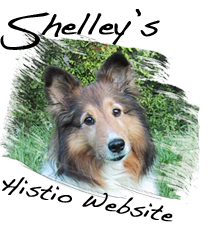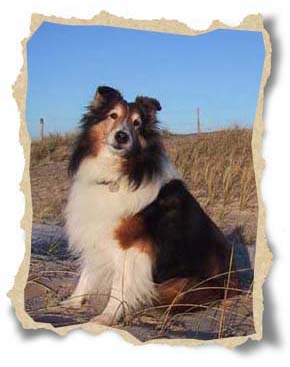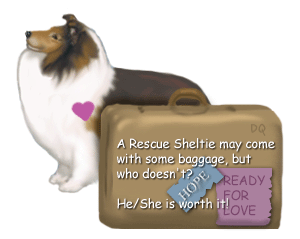
INFORMATION
Dutch pagesContact
Links
Disclaimer
DOGGY WISDOM
EuthanasiaLyme disease and Shelby
Puppy Mills
Reverse Sneezing
Second Hand Dog
Heat stroke in dogs
HISTIOCYTOSIS
Histiocytosis in DogsHistio Patient Stories
Survey Questions (download)
Histio Survey Report
Histio Forum
IMMUNE SYSTEM
Immune-mediated diseasesAutoimmune disease
SHELTIES
CorkyPhoebe
Pedigrees
Photo & Video Archives
Rainbow bridge
Animals and the Afterlife
Sheltie Art
The second-hand dog
A DOG WITH A PREVIOUS LIFE
by Mo van den Tillaart

 It so happened that we have been taking care of two Shelties that had previous owners, before they transplanted to the Netherlands and ended up with us. They were both born and raised in California (USA). The first one was called Leo, he was approximately 8 years old, and the second one was Sunny, he was 4 years old.
It so happened that we have been taking care of two Shelties that had previous owners, before they transplanted to the Netherlands and ended up with us. They were both born and raised in California (USA). The first one was called Leo, he was approximately 8 years old, and the second one was Sunny, he was 4 years old.
Leo had a reputation of running away from the home whenever he had the chance. Sunny didn't have that reputation, but he did it anyway. Leo slipped out through my legs when I opened the door carrying a bag of groceries after 10 days in our care. Sunny ran out on the 4th day in our care, when my mother-in-law came through the door and closed it too slowly. She screamed and Sunny spooked and was gone. No use calling them back, because they ignored me. Of course they had no reason to come back to me, because they did not know me yet. I was a mere stranger to them. We have been lucky both times. I caught Leo after he crossed a very busy intersection (!) and Sunny was discovered in someones backyard the next day. From then on we took precautions. We installed a wicket in the hall, so no dog would ever run away again.
This running away is a main concern when you decide to take care of a second-hand dog, for they don't feel at home right away. There is no relationship or loyalty yet. It can take several months of tender loving care and good food before an older dog gets used to its new owners. So there are a few very important rules to follow when you consider taking care of a second-hand dog. Make sure that all outside entrance doors are always closed securely and the gate is latched in a fenced yard. Also make sure that the collar will not come off the head too easy, not even when pulled on. Write name and address on the collar (just in case). And my most important advise: never ever open any outside entrance door BEFORE you have the dog securely in its crate, or attached to a leash.
There are so many situations that can cause your second-hand dog to run away. You yourself can be very careful, but others, like little children and/or visitors, can cause the problem for you. For instance:
- Someone else walks the dog. When the leash is not held tightly enough, the dog can pull away and run off.
- You let the dog out into the yard, but the gate is open.
- Someone opens the door for the mailman and the dog slips out.
- A visiting friend goes outside to get something from his car, and forgets to close the door behind him.
- Your kid runs out a slow closing door. The dog follows the child and is gone.
- Also realise that dogs can dig themselves out of a fenced yard, or jump over the fence.
- Or, when you open the car door without having the dog in a crate or tied to a seat belt, the dog can slip out.
So you see, there is a lot that can go wrong. And according to Murphy's Law, anything that can go wrong, will go wrong. Keep that in mind.
 In order to become a trustworthy pet, your second-hand dog needs an enormous amount of tender loving care and attention from its new owner. Be with him as much as possible and shower the dog with treats and hugs. Know that the dog needs lots of company, contact and bonding activities, like grooming and training. That restores his sense of worth, pride and dignity. Frequent short leashed walks will help the dog familiarize with its new surroundings and become more comfortable with you. It will also help you housebreak the dog, if it wasn't already.
In order to become a trustworthy pet, your second-hand dog needs an enormous amount of tender loving care and attention from its new owner. Be with him as much as possible and shower the dog with treats and hugs. Know that the dog needs lots of company, contact and bonding activities, like grooming and training. That restores his sense of worth, pride and dignity. Frequent short leashed walks will help the dog familiarize with its new surroundings and become more comfortable with you. It will also help you housebreak the dog, if it wasn't already.
During the first few days, your new dog will be very quiet, but after a week or so, the dog will probably begin to bark when the doorbell rings or at people coming in the house. This might be the first sign that the dog is starting to feel a little bit comfortable. However, that does not mean you have to allow him to bark all the time. Obedience training would be a very good idea.
Introduce your rules and regulations right away. The dog needs a strong leader to call the shots. Usually problems will slowly depart if trained firmly. Be consequent. And be aware that a dog with a bad history will be less flexible than a dog that grew up in a loving environment. You can only guess at some of the things that might have happened to him before he came to you.
We know that many older dogs are successfully adopted. It can be tough in the beginning, but in the end there is a reward: unconditional love, loyalty and companionship by your furry friend who thinks you are the most wonderful person in the world!


